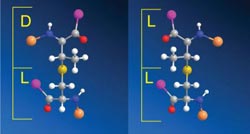Odd biochemistry yields lethal bacterial protein

One enzyme shapes the components of a bacterial protein into rings with right-handed (D) and left-handed (L) stereochemistries.<br><br>Credit: Graphic by Weixin Tang<br>
The new findings, reported in Nature Chemical Biology, should help scientists find new ways to target the enterococcal cytolysin protein, a “virulence factor that is associated with acute infection in humans,” said University of Illinois chemistry and Institute for Genomic Biology professor Wilfred van der Donk, who conducted the study with graduate student Weixin Tang.
Enterococcus faecalis (EN-ter-oh-cock-us faye-KAY-liss) is a normal microbial inhabitant of the gastrointestinal tracts of humans and other mammals and generally does not harm its host. Some virulent strains, however, produce cytolysin (sigh-toe-LIE-sin), a protein that, once assembled, attacks other microbes and kills mammalian cells.
“The cytolysin protein made by Enterococcus faecalis consists of two compounds that have no activity by themselves but when combined kill human cells,” van der Donk said. “We know from epidemiological studies that if you are infected with a strain of E. faecalis that has the genes to make cytolysin, you have a significantly higher chance of dying from your infection.” E. faecalis contributes to root canal infections, urinary tract infections, endocarditis, meningitis, bacteremia and other infections.
Enterococcal cytolysin belongs to a class of antibiotic proteins, called lantibiotics, which have two or more sulfur-containing ring structures. Scientists had been unable to determine the three-dimensional structure of this cytolysin because the bacterium produces it at very low concentrations. Another problem that has stymied researchers is that the two protein components of cytolysin tend to clump together when put in a lab dish.
Van der Donk and Tang got around these problems by producing the two cytolysin components separately in another bacterium, Escherichia coli (esh-uh-REE-kee-uh KOH-lie), and analyzing them separately.
“The two components are both cyclic peptides, one with three rings and the other with two rings,” van der Donk said. “Curiously, a single enzyme makes both compounds.”
In a series of experiments, the researchers found that one ring on each of the proteins adopted a (D-L) stereochemistry that is common in lantibiotics (see image, above). But the other rings all had an unusual (L-L) configuration, something van der Donk had never seen before.
Scientists had assumed that the enzyme that shaped enterococcal cytolysin, a lantibiotic synthetase, acted like a three-dimensional mold that gave the ring structures of cytolysin the exact same stereochemistry, van der Donk said.
“But we found that the enzyme, enterococcal cytolysin synthetase, makes the rings with different stereochemistry,” he said. “I don't know of any other examples where one enzyme can make very similar products but with different stereochemistries.”
The researchers don't know how the enzyme accomplishes this feat, but found a clue in the sequence of amino acids that make up the protein rings. The chemical characteristics of the three amino acids in the middle of the ring structure and their proximity to another amino acid, a cysteine, determined whether the rings took on a D-L or L-L stereochemistry.
The researchers tested the idea that the amino acid sequence of the cytolysin protein was guiding the stereochemistry by looking at other lantibiotic proteins with similar sequences. So far, every protein they've tested that has the same sequence characteristics conforms to the pattern they discovered, van der Donk said.
Further tests showed that the cytolysin produced in E. coli had the same anti-microbial and cell-killing potency as the E. faecalis variety.
“Knowing the structure of enterococcal cytolysin and having a method to produce it in relatively large quantities will allow scientists to find out how it kills human cells and, in turn, how we might fight against it,” van der Donk said.
The National Institutes of Health supported this research. Van der Donk also is a Howard Hughes Medical Institute investigator.
Editor's notes:
To reach Wilfred van der Donk, call 217-244-5360; email vddonk@illinois.edu.
The paper, “The Sequence of the Enterococcal Cytolysin Imparts Unusual Lanthionine Stereochemistry,” is available to the media from the U. of I. News Bureau.
Media Contact
More Information:
http://www.illinois.eduAll latest news from the category: Studies and Analyses
innovations-report maintains a wealth of in-depth studies and analyses from a variety of subject areas including business and finance, medicine and pharmacology, ecology and the environment, energy, communications and media, transportation, work, family and leisure.
Newest articles

Superradiant atoms could push the boundaries of how precisely time can be measured
Superradiant atoms can help us measure time more precisely than ever. In a new study, researchers from the University of Copenhagen present a new method for measuring the time interval,…

Ion thermoelectric conversion devices for near room temperature
The electrode sheet of the thermoelectric device consists of ionic hydrogel, which is sandwiched between the electrodes to form, and the Prussian blue on the electrode undergoes a redox reaction…

Zap Energy achieves 37-million-degree temperatures in a compact device
New publication reports record electron temperatures for a small-scale, sheared-flow-stabilized Z-pinch fusion device. In the nine decades since humans first produced fusion reactions, only a few fusion technologies have demonstrated…





















